NVIDIA GeForce GTX 670 Review Feat. EVGA: Bringing GK104 Down To $400
by Ryan Smith on May 10, 2012 9:00 AM ESTCompute
Shifting gears, as always our final set of benchmarks is a look at compute performance. As we have seen with GTX 680, GK104 appears to be significantly less balanced between rendering and compute performance than GF110 or GF114 were, and as a result compute performance suffers. Cache and register file pressure in particular seem to give GK104 grief, which means that GK104 can still do well in certain scenarios, but falls well short in others.
Our first compute benchmark comes from Civilization V, which uses DirectCompute to decompress textures on the fly. Civ V includes a sub-benchmark that exclusively tests the speed of their texture decompression algorithm by repeatedly decompressing the textures required for one of the game’s leader scenes. Note that this is a DX11 DirectCompute benchmark.
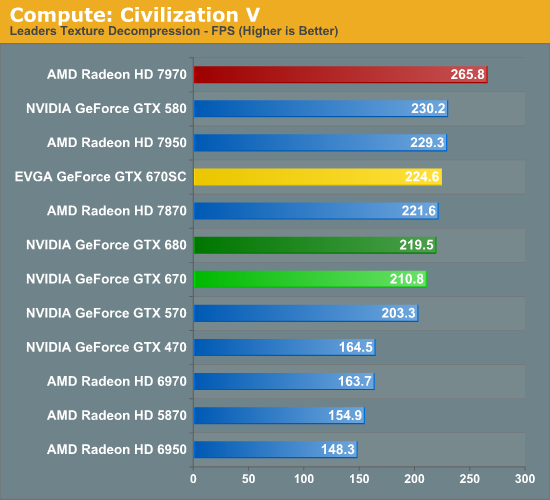
It’s quite shocking to see the GTX 670 do so well here. For sure it’s struggling relative to the Radeon HD 7900 series and the GTX 500 series, but compared to the GTX 680 it’s only trailing by 4%. This is a test that should cause the gap between the two cards to open up due to the lack of shader performance, but clearly that this not the case. Perhaps we’ve been underestimating the memory bandwidth needs of this test? If that’s the case, given AMD’s significant memory bandwidth advantage it certainly helps to cement the 7970’s lead.
Our next benchmark is SmallLuxGPU, the GPU ray tracing branch of the open source LuxRender renderer. We’re now using a development build from the version 2.0 branch, and we’ve moved on to a more complex scene that hopefully will provide a greater challenge to our GPUs.
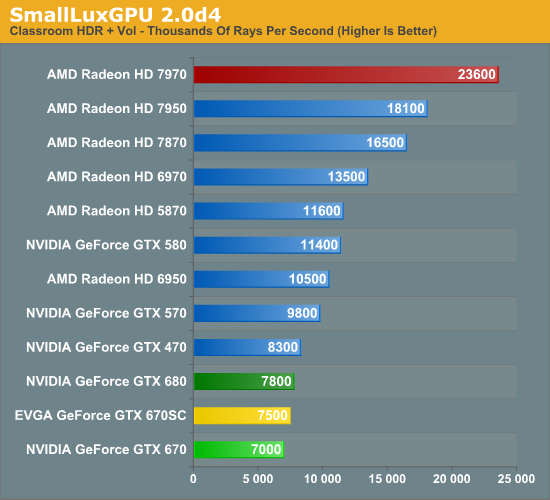
SmallLuxGPU on the other hand finally shows us that larger gap we’ve been expecting between the GTX 670 and GTX 680. The GTX 680’s larger number of SMXes and higher clockspeed cause the GTX 670 to fall behind by 10%, performing worse than the GTX 570 or even the GTX 470. More so than any other test, this is the test that drives home the point that GK104 isn’t a strong compute GPU while AMD offers nothing short of incredible compute performance.
For our next benchmark we’re looking at AESEncryptDecrypt, an OpenCL AES encryption routine that AES encrypts/decrypts an 8K x 8K pixel square image file. The results of this benchmark are the average time to encrypt the image over a number of iterations of the AES cypher.
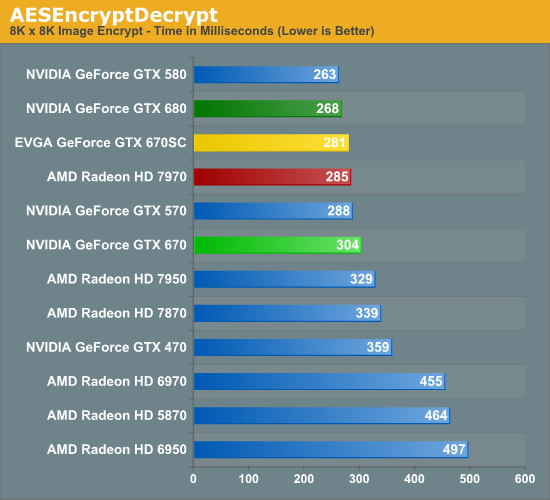
Once again the GTX 670 has a weak showing here, although not as bad as with SmallLuxGPU. Still, it’s enough to fall behind the GTX 570; but at least it’s enough to beat the 7950. Clockspeeds help as showcased by the EVGA GTX 670SC but nothing really makes up for the missing SMX.
Our foruth benchmark is once again looking at compute shader performance, this time through the Fluid simulation sample in the DirectX SDK. This program simulates the motion and interactions of a 16k particle fluid using a compute shader, with a choice of several different algorithms. In this case we’re using an (O)n^2 nearest neighbor method that is optimized by using shared memory to cache data.
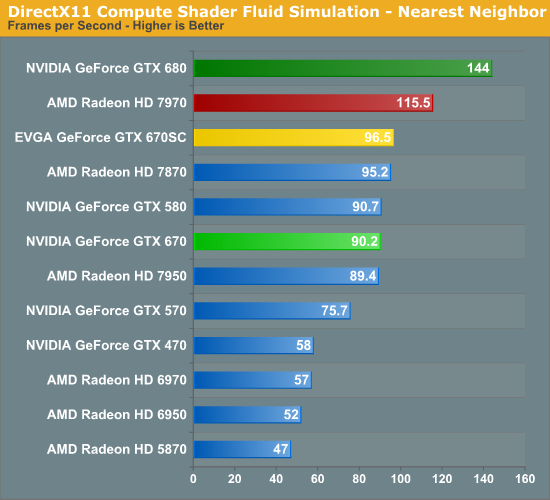
For reasons we’ve yet to determine, this benchmark strongly dislikes GTX 670 in particular. There doesn’t seem to be a performance regression in NVIDIA’s drivers, and there’s not an incredible gap due to TDP, it just struggles on the GTX 670. As a result performance of the GTC 670 only hits 42% of the GTX 680, which is well below what the GTX 670 should theoretically be getting. Barring some kind of esoteric reaction between this program and the unbalanced GPC a driver issue is still the most likely culprit, but it looks to only affect the GTX 670.
Finally, we’re adding one last benchmark to our compute run. NVIDIA and the Folding@Home group have sent over a benchmarkable version of the client with preliminary optimizations for GK104. Folding@Home and similar initiatives are still one of the most popular consumer compute workloads, so it’s something NVIDIA wants their GPUs to do well at.
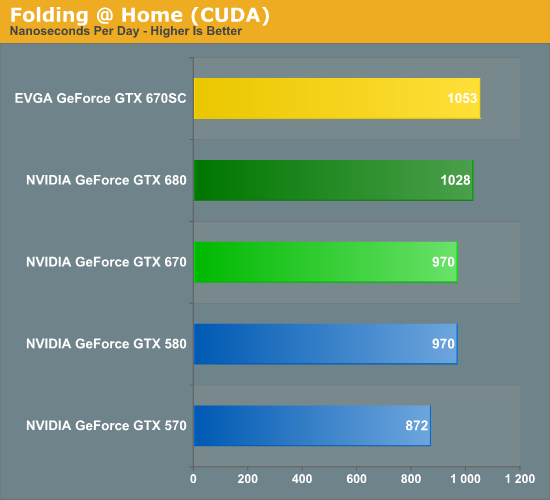
Whenever NVIDIA sends over a benchmark you can expect they have good reason to, and this is certainly the case for Folding@Home. GK104 is still a slouch given its resources compared to GF110, but at least it can surpass the GTX 580. At 970 nanoseconds per day the GTX 670 can tie the GTX 580, while the GTX 680 can pull ahead by 6%. Interestingly this benchmark appears to be far more constrained by clockspeed than the number of shaders, as the EVGA GTX 670SC outperforms the GTX 680 thanks to its 1188MHz boost clock, which it manages to stick to the entire time.










414 Comments
View All Comments
Spunjji - Friday, May 11, 2012 - link
Thank you for being a voice of sanity in an otherwise brutally argumentative and deeply sad comments section. +1 to you.CeriseCogburn - Friday, May 11, 2012 - link
"Voice of sanity" your amd fanboy friend, got the 43% larger amd wafer die size "cost drop not a problem" a bit overlooked, not to mention the 3 added free games additional cost.Is it a voice of reason to claim the largest base cost of the card at 43% greater is no problem since the "dies" are "about the same size" ?
ROFL... tsk tsk.
SlyNine - Saturday, May 12, 2012 - link
Its 43% greater now.Also you seem to forget the 7970 wins in 5 out of 10 of Anandtechs benchmarks.
Since you're going to argue this with me I'll put it out right now.
Crysis AMD
Metro AMD
Dirt 3 ( on the MOST Intensive test 5760x1200 min frames) Tied, but to me min frames is more important so I'd rather have AMD in that situation.
Now you can argue , But NVidia wins on the other res's But since this is the ONLY time it even gets below 60 this is the ONLY test that it really makes a difference.
ShoGun, AMD, big time, ya nvidia wins when FPS is over 100, but AMD wins by a lot when FPS is at a premium. With a driver fix I'm sure it will be a lot closer.
Batman, Basically a tie, yea Nvidia takes it but C'mon, 1 fps when it matters most. My guess is if they added 4x aa to the 3 screen mode AMD would take it.
Portal 2 Nvidia kills AMD, esp. in the high res, because that's where fps are low enough that the diff matters.
Battlefield 3 Nvidia kills amd again. and again when FPS matters.
SC2, Nvidia is faster. FPS is so high it doesn't matter But AMD is catching up fast and with the 5760res I wonder if AMD wouldn't' win. and by then FPS might actually matter.
Skyrim, same as SC2, AMD is catching up fast at the higher resolution, if it keeps going AMD might come out ahead where FPS is low enough that the difference matters.
Civ 5, tie. With the trend the Nvidia might be better at higher res here.
Portal 2 and BF3 are the to situation in Anands testing suit where Nvidia is MUCH better.
But other than that FPS either doesn't matter or AMD is winning when FPS is low enough that the difference matters.
As far as future games, we have NO idea what card might be better, but AMD does seem to have more raw power, and has more ram.
In compute AMD won 2 , loses one by like 7% and then actually loses one by a lot. Of course it doesn't have a cuda score so how to you count that as a loss, that's stupid.
CeriseCogburn - Sunday, May 13, 2012 - link
You make excuses across the board for the amd card, and nVidia's card is a smoother experience anyway if you want to glom onto min frames - and we haven't even used things like adaptive v-sync (better min frame rates for nVidia), nor did you figure in the enormous drivers difference.It's just such a huge gap when everything is considered it's beyond ridiculous to go for the amd card, as this amd favoring reviewer even admits.
Have your favorite brand, but you've got stretch and spin to justify it.
Galidou - Sunday, May 13, 2012 - link
I could just really stop answering you if that wasn't for the fact you're being so much disrespectful. I have a little problem with people lacking of respect, I have to let them know they are, even more when they do not think they are lacking respect...CeriseCogburn - Sunday, May 13, 2012 - link
You have never answered anything late comer troll Galidou, you're a pure 100% trolling personal attacker right now fella in all your posts so far. You have said absolutely nothing, so it is clear you should have never posted.Galidou - Monday, May 14, 2012 - link
I'm not attacking your person, just the way you throw your arguments at people calling them names like they are pure ignorant worthless living zombies... it just feels that way...Gastec - Tuesday, November 13, 2012 - link
"You make excuses across the board for the amd card, and nVidia's card is a smoother experience[..] - and we haven't even used things like..."We? WE?? YOU are from NVIDIA???? And you post here and admit it? I think you can get fired for doing this.
Or maybe you are not from nVidia but because you use a nVidia card you, for some very disturbing reason, feel like you are part of the company?
CeriseCogburn - Friday, May 11, 2012 - link
Okay, first of all substantial competition is the GTX590 and the 6990, that both still beat the overpriced amd lost 3 and only won 2 compute benchmarks in that 2.5+ month evil amd price scalping period before the massive smack down the nVidia 680 delivered.Now nVidia made a third move, the 670, not the initial move as you spoke about it, and this third move is another massive smackdown on the already smacked down by the 680 failing and utterly depleted value 7970 has to endure.
Nice try pretending the 1st smack down just occurred, but once again, what else to expect from an amd fanboy, and also clearly why another amd fanboy immediately thanked you a perfectly leveled headed post. LOL
Now onto your other ridiculous spew, based on facts not twisted perceptions.
You note the die sizes of the competing products, and conclude by stupid first look there is no reason amd cannot drop it's price (again) - you avoid the again, twice - (once for $$$(yes 3 figures), twice for 3 games added, now a 3rd time coming ) - but whatever, let's take your die size non chalant info and do our little math amd fanboys now desperately want to avoid.
300mm sq. nVidia vs 365mm sq Amd - doesn't look so bad does it ?
Unfortunately, the Amd die is well over 40% LARGER :)
Sorry about that amd fanboy brainfart .... you forgot to multiply for AREA, hence size/cost of the wafer....
300x300 vs 365x365
90,000 nVidia wafer area vs 133,225 huge 43% + more amd wafer cost.
So let's get this straight - do you still not really see a problem ?
yankeeDDL > " AMD will need to drop the prices and I see really no reason why they couldn't, as they have just a marginally larger die size (300mm2 vs 365mm2) on the same fab/technology. "
So 43% plus more base cost, no problem going a hundred bucks + games costs less... ?
R O F L
Thank you, as the amd fanboy said, for being such a clear thinking person with a calm and fair mind... (rolls eyes)
SlyNine - Saturday, May 12, 2012 - link
Its hard to say the 680 was a smack down when most people couldn't even get the card..You seem to be angered by the 7970. I agree that it was not a good deal. But its not a bad card either.